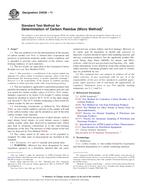Potřebujeme váš souhlas k využití jednotlivých dat, aby se vám mimo jiné mohly ukazovat informace týkající se vašich zájmů. Souhlas udělíte kliknutím na tlačítko „OK“.
ASTM D4530-11
Standard Test Method for Determination of Carbon Residue (Micro Method)
Automaticky přeložený název:
Standardní zkušební metoda pro stanovení uhlíku, zbytek (Micro Method)
NORMA vydána dne 15.5.2011
Informace o normě:
Označení normy: ASTM D4530-11
Poznámka: NEPLATNÁ
Datum vydání normy: 15.5.2011
Kód zboží: NS-27604
Počet stran: 7
Přibližná hmotnost: 21 g (0.05 liber)
Země: Americká technická norma
Kategorie: Technické normy ASTM
Anotace textu normy ASTM D4530-11 :
Keywords:
carbon residue, carbon residue (micro method), diesel fuel, lubricating oil, petroleum products, Residue--petroleum products, Micro-carbon residue, Petroleum products, ICS Number Code 75.080 (Petroleum products in general)
Doplňující informace
| Significance and Use | ||||||||||||||
|
The carbon residue value of the various petroleum materials serves as an approximation of the tendency of the material to form carbonaceous type deposits under degradation conditions similar to those used in the test method, and can be useful as a guide in manufacture of certain stocks. However, care needs to be exercised in interpreting the results. |
||||||||||||||
| 1. Scope | ||||||||||||||
|
1.1 This test method covers the determination of the amount of carbon residue (see Note 1) formed after evaporation and pyrolysis of petroleum materials under certain conditions and is intended to provide some indication of the relative coke forming tendency of such materials. 1.2 The test results are equivalent to the Conradson Carbon Residue test (see Test Method D189). Note 1—This procedure is a modification of the original method and apparatus for carbon residue of petroleum materials, where it has been demonstrated that thermogravimetry is another applicable technique. However, it is the responsibility of the operator to establish operating conditions to obtain equivalent results when using thermogravimetry. 1.3 This test method is applicable to petroleum products that partially decompose on distillation at atmospheric pressure and was tested for carbon residue values of 0.10 to 30 % (m/m). Samples expected to be below 0.10 weight % (m/m) residue should be distilled to remove 90 % (V/V) of the flask charge (see Section 9). The 10 % bottoms remaining is then tested for carbon residue by this test method. 1.4 Ash-forming constituents, as defined by Test Method D482, or non-volatile additives present in the sample will add to the carbon residue value and be included as part of the total carbon residue value reported. 1.5 Also in diesel fuel, the presence of alkyl nitrates, such as amyl nitrate, hexyl nitrate, or octyl nitrate, causes a higher carbon residue value than observed in untreated fuel, which may lead to erroneous conclusions as to the coke-forming propensity of the fuel. The presence of alkyl nitrate in the fuel may be detected by Test Method D4046. 1.6 The values stated in SI units are to be regarded as standard. No other units of measurement are included in this standard. 1.6.1 Exception—6.4 and 6.5 include inch-pound units. 1.7 WARNING—Mercury has been designated by many regulatory agencies as a hazardous material that can cause central nervous system, kidney and liver damage. Mercury, or its vapor, may be hazardous to health and corrosive to materials. Caution should be taken when handling mercury and mercury containing products. See the applicable product Material Safety Data Sheet (MSDS) for details and EPA’s websitehttp://www.epa.gov/mercury/faq.htmfor additional information. Users should be aware that selling mercury and/or mercury containing products into your state or country may be prohibited by law. 1.8 This standard does not purport to address all of the safety concerns, if any, associated with its use. It is the responsibility of the user of this standard to establish appropriate safety practices and to determine the applicability of regulatory limitations prior to use. For specific warning statements, see 8.2.3 and 8.4. |
||||||||||||||
| 2. Referenced Documents | ||||||||||||||
|
Doporučujeme:
EviZak - všechny zákony včetně jejich evidence na jednom místě
Poskytování aktuálních informací o legislativních předpisech vyhlášených ve Sbírce zákonů od roku 1945.
Aktualizace 2x v měsíci !
Chcete vědět více informací? Podívejte se na tuto stránku.




 Cookies
Cookies
